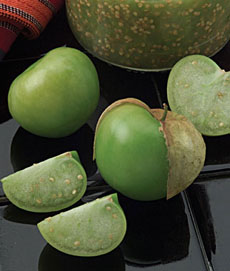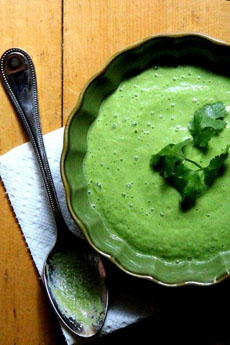RECIPE: Gazpacho Verde
|
On really hot summer days, we like to cool down with a chilled meal. A bowl of gazpacho and a large salad, accompanied by lots of iced tea, fit the bill.
Gazpacho, a low-calorie, high-nutrition dish, is one of those recipes that afford maximum customization: Each cook can do his or her thing, and even a favorite recipe can be tweaked each time it is made. That’s good news right now, since our stores and farmers markets stores are filled with pricey hothouse tomatoes. If there’s a bumper crop of tomatoes in August or early September and the price goes down, that’s the time to make tomato-based gazpacho. We love the ease of gazpacho: Toss chopped vegetables into the blender, and in a minute you’ve got soup. |
Gazpacho verde garnished with diced avocado. Photo courtesy Pink Sands Resort | Bahamas. |
|
|
Chef Ed Boncich of Pink Sands Resort in the Bahamas has shared his gazpacho verde recipe with us: GAZPACHO VERDE RECIPE Ingredients
*Canned tomatillos can be substituted for fresh ones, but the flavor of fresh tomatillos is far superior. Tomatillos are not “little tomatoes”; they are cousins of tomatoes. While both are members of the nightshade family, Solanaceae, they have a different genus: Physalis for tomatillos (P. philadelphica) and Solanum for tomatoes (S. lycopersicum). |
||
 Tomatillos. Photo courtesy Burpee.com, which sells the seeds to grow your own. |
Preparation 1. ROUGHLY chop the cucumber, onion, peppers, tomatillos and avocado and place them in a blender (you may have to add blend it in two batches). 2. ADD the rice wine vinegar and oil and blend until smooth. Add the hot pepper sauce. If you’ve added too hot, dilute it by adding additional rice wine vinegar or some honey. 3. CHILL. Garnish and serve. Dairy Garnishes chopped fresh herbs) |
|
|
Non-Dairy Garnishes Gazpacho is a cold raw vegetable soup that originated in Andalusia, the southernmost region of Spain. The name is of Arabic origin, and literally means “soaked bread,” an ingredient of early recipes that made use of the prior day’s stale bread. The term has become generic for “cold vegetable soup.” The original recipe came from the Arabs who occupied much of Spain from the 8th through the 13th centuries. Early on, gazpacho was a way for field workers to make lunch from the vegetables at hand. The recipe typically included stale bread, bell pepper, garlic, olive oil, onion, tomato, wine vinegar and salt—which remains the Andalusian style. Since the tomato is a New World fruit that was not eaten in Europe until the 1800s*, the earliest gazpacho was made without it. There are many variations of gazpacho, depending on local ingredients and preferences. American recipes tend to leave out the bread, although some garnish the soup with a garlic crouton. White gazpacho is made with olive oil, sherry vinegar, bread, garlic and salt, and substitutes green grapes and almonds for the vegetables. Check out the history of soup and the most popular soups in our Soup Glossary.
|
||



